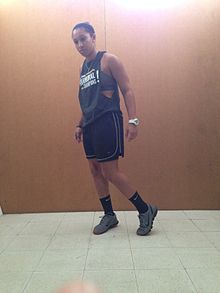User:Dhiguera1091/sandbox
Regional[edit]
In the United States acetabular labrum tears usually occur in the anterior or anterior-superior area, possibly due to a sudden change from labrum to acetabu lar cartilage [1]. The most common labrum tears in Japan are in the posterior region, likely due to the customary practice of sitting on the floor [2]. Posterior labrum tears in the Western world usually occur when a force drives the femoral head posteriorly which transfers shear and compressive forces to the posterior labrum [3].
Etiology[edit]
Traumatic injuries are most commonly seen in athletes who participate in contact or high impact sports like football, soccer, or golf [4]. The prevalence rate for traumatic hip injuries that causes a tear of the labrum is very low. Less than 25% of all patients can relate a specific incident to their torn labrum, however they are often a result of a dislocation or fracture [5]. Falling on one’s side causes a blunt trauma to the greater trochanter of the femur. Since there is very little soft tissue to diminish the force between the impact and the greater trochanter, the entire blow is transferred to the surface of the hip joint [6]. And since bone density does not reach its peak until the age of 30, hip traumas could result in a fracture [7].
Anatomical modifications of the femur and or hip socket cause a slow build up of damage to the cartilage. Femur or acetabular dysplasia can lead to femoral acetabular impingement also known as FAI [8]. Impingement occurs when the femoral head rubs abnormally or its lacks a full range of motion in the acetabular socket [9]. There are 3 different forms of FAI. The first form is caused by a cam-deformity where extra bone is present on the femoral head, which leads to the head being non-spherical [10]. The second deformity is referred to as a pincer deformity and it is due to an excess growth of the acetabular socket [11]. The third type of FAI is a combination of the first two deformities. When either abnormality is present, it changes the position the femoral head sits in the hip socket. The increased stresses that the femur and or acetabulum experience may lead to a fracture of the acetabular rim or a detachment of the overstressed labrum [12].

- ^ Smith, M., Panchal, H., Ruberte, R., & Sekiya, J. (2011). Effect of acetabular labrum tears on hip stability and labral strain in a joint compression model. The American Journal of Sports Medicine, 39, 103S-110S.
- ^ Groh, M., & Herrera, J. (2009). A comprehensive review of hip labral tears. Current Reviews in Musculoskeletal Medicine, 2, 105-117.
- ^ Groh, M., & Herrera, J. (2009). A comprehensive review of hip labral tears. Current Reviews in Musculoskeletal Medicine, 2, 105-117.
- ^ Groh, Megan M., and Joseph Herrera. "A Comprehensive Review of Hip Labral Tears." Curr Rev Musculoskeletal Med. 2.2 (2009): 105-117. Web. 16 Oct. 2013
- ^ Mason, J. Bohannon MD. "Acetabular Labral Tears In The Athlete." Clinics In Sports Medicine. 20.4 (2001): 779-788. Web. 16 Oct. 2013.
- ^ Byrd, J.W. Thomas. "Lateral Impact Injury." Clinics In Sports Medicine. 20.4 (2001): 801-815. Web. 16 Oct. 2013
- ^ Byrd, J.W. Thomas. "Lateral Impact Injury." Clinics In Sports Medicine. 20.4 (2001): 801-815. Web. 16 Oct. 2013
- ^ Rahman, Abdel, Sathish Rajasekaran, and Haron Obaid. "MRI Morphometric Hip Comparison Analysis of Anterior Acetabular Labral Tears." Skeletal Radiol. (2013): 1246-1252. Web. 17 Oct. 2013
- ^ Rahman, Abdel, Sathish Rajasekaran, and Haron Obaid. "MRI Morphometric Hip Comparison Analysis of Anterior Acetabular Labral Tears." Skeletal Radiol. (2013): 1246-1252. Web. 17 Oct. 2013
- ^ Groh, Megan M., and Joseph Herrera. "A Comprehensive Review of Hip Labral Tears." Curr Rev Musculoskeletal Med. 2.2 (2009): 105-117. Web. 16 Oct. 2013
- ^ Groh, Megan M., and Joseph Herrera. "A Comprehensive Review of Hip Labral Tears." Curr Rev Musculoskeletal Med. 2.2 (2009): 105-117. Web. 16 Oct. 2013
- ^ Groh, Megan M., and Joseph Herrera. "A Comprehensive Review of Hip Labral Tears." Curr Rev Musculoskeletal Med. 2.2 (2009): 105-117. Web. 16 Oct. 2013

